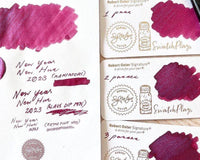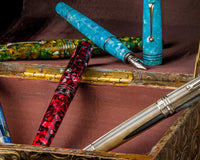The question of whether a fountain pen can be used interchangeably with a dip pen may come up for stationery enthusiasts at some point. Since both have nibs and use liquid ink, the fountain pen might seem like a great substitute for the dip pen. However, the answer may not be as straightforward, so we’re here to unpack and examine the differences in these writing tools.
Fountain pens vs. Dip pens
At first glance, fountain pens and dip pens may seem like pretty much the same writing instrument. They share many similarities but are also unique in their own ways.
Fountain pens

The history of the fountain pen goes back several centuries, but it was in the 19th century that it began to gain mainstream attention and use thanks to Romanian inventor Petrache Poenaru. The invention of the fountain pen gained traction and went through several iterations and improvements until it became the modern fountain we know and love today.
Unlike dip pens, fountain pens have converters, cartridges, and other internal ink reservoirs that ensure ink is constantly being fed into the nib. This takes away the need to dip your nib into an ink bottle.
Both fountain pens and dip pens come in different nib types and sizes. However, not many fountain pens allow the writer to switch nibs as easily. Most will have to purchase an entirely new pen if the manufacturer does not specify that nibs can be swapped. Dip pens, on the other hand, are designed so that you can change nibs easily.
Dip pens

Dip pens have a longer history than fountain pens. The earliest form of such pens were the quills used during medieval times. As the name suggests, dip pens need to be dipped into an inkwell so that its user can write with it.
Most dip pens are made of a pen handle (typically made of wood) and come with different-shaped and sized nibs to insert into the handle. Unlike fountain pens, dip pens have no built-in ink reservoir. Instead, their nibs have indentations that hold just enough ink so that the dip pen does not need to be dipped in ink too often as it might interrupt one’s writing.
Many people compare fountain pens to dip pens, but it would be more accurate to compare fountain pens to everyday pens, such as ballpoint or gel pens. That’s because fountain pens are designed for daily use, such as signing papers, jotting down notes, or writing letters. Dip pens are typically used for calligraphy and more artistic writing.
Using a fountain pen as a dip pen
Technically, a fountain pen can be used in the same way as a dip pen. You can take any fountain pen you have, dip the nib into an ink bottle (make sure it’s clean!), and then write like you would normally. In fact, this is how many people try new fountain pens for the first time. However, the capillary action of the nib and feed will only soak up enough ink for a few sentences. This defeats the purpose of a fountain pen, which allows you to hold a large amount of ink in its reservoir for continuous writing.
If you wish to use a fountain pen as a dipping pen, you may as well purchase a separate dipping pen altogether. It will be much easier to change ink colors and nib sizes, allowing you to do lettering work, calligraphy, and even sketches.
One of the biggest differences when writing with fountain pens and dip pens is the ink used. Dip pen inks use much thicker inks compared to fountain pen inks. While you can use fountain pen inks in dip pens, it is not advisable to use dip pen ink in fountain pens as they can clog your feed and nib.
The Bottom Line
Even though fountain pens and dip pens write in very similar ways, they are still quite different from one another. Deciding which one is better for your needs and preferences will depend on how you will use them. For those looking for an everyday writing tool that is great for note-taking, journaling, and other similar tasks, a fountain pen would be most suitable. If you love ink calligraphy or want to experiment with different styles and ink colors, then it may be worth investing in a dip pen, like the Iro-utsushi Wooden Dip Pen from Pilot.
As always, happy writing!
Written by EndlessPens Blogger Ramona Kabigting








2 comments
Alan
Nice article. I have a pair of Lamy Safari fountain pens with medium nibs that, for whatever reason, simply will NOT write more than a couple of sentences before drying up and refusing to write. I’ve tried everything. Multiple flushes and other things. Nothing worked. So, before I through these dogs into the trash, wouldn’t it be best to just use them as dip pens? Can’t think I have much to lose.
M. Lande Weissman
I enjoyed your helpful, thoroughly informative article on fountain (vs. ‘dip’) pens.
Thanks for sharing your “pensive” thoughts on the subject. (Write on…!)